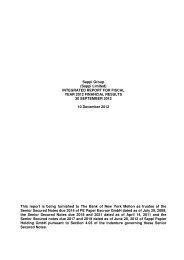2007 Annual Report - Sappi
2007 Annual Report - Sappi
2007 Annual Report - Sappi
Create successful ePaper yourself
Turn your PDF publications into a flip-book with our unique Google optimized e-Paper software.
31. Financial Instruments<br />
The group’s financial instruments consist mainly of cash and cash equivalents, accounts receivable, certain investments,<br />
accounts payable, borrowings and derivative instruments.<br />
1. Risk management objectives and policies<br />
The principal market risks (that is the risk of loss arising from adverse changes in market rates and prices) to which <strong>Sappi</strong> is<br />
exposed through financial instruments are:<br />
– interest rates on interest-bearing borrowings;<br />
– foreign exchange rates, generating translation and transaction gains and losses; and<br />
– credit risk.<br />
A treasury committee consisting of senior management of the group meets regularly to review net currency, interest rate,<br />
derivative instruments, group funding, credit insurance and monetary investment risks and exposures. Treasury management<br />
strategies are also evaluated and revised where necessary. The treasury policy is formally documented and these policies<br />
are the guidelines for the decisions that are made by the treasury committee.<br />
Interest rate risk<br />
<strong>Sappi</strong> has a policy of maintaining a balance between fixed rate and variable rate loans that enables it to minimise, on a cost<br />
effective basis, the impact on reported earnings while maintaining a reasonably competitive, market-related cost of funding.<br />
The specific balance is determined separately for the European, North American and Southern African businesses of <strong>Sappi</strong><br />
to reflect more accurately the different interest rate environments in which these businesses operate. We monitor market<br />
conditions and may utilise interest rate derivatives to alter the existing balance between fixed and variable interest loans in<br />
response to changes in the interest rate environment.<br />
Currency risk<br />
<strong>Sappi</strong>’s foreign exchange policy consists of the following principal elements:<br />
– The majority of the borrowings in each country are made in the currency of that country;<br />
– Translation risks are not hedged;<br />
– All external borrowings raised in currencies other than the domestic operating currency of the borrowing entity are<br />
immediately and continuously protected by forward exchange contracts;<br />
– All consummated (i.e. invoiced) sales and purchases in foreign currencies are initially netted on a global basis, with the resulting<br />
net exposure generally being covered by forward exchange contracts against subsequent fluctuations in exchange rates;<br />
– Hedging against trading transactions not yet invoiced is limited. Deviations from these rules require specific board approval;<br />
– Material capital expenditures for which forward exchange contracts are always taken out as and when the expenditure is<br />
committed; and<br />
– Anticipated exports and imports where the purchase of forward exchange contracts/currency options is restricted to a<br />
limited portion of expected orders.<br />
Credit risk<br />
Credit risk exposures arise mainly from:<br />
– investing in or dealing with financial counterparties which is the responsibility of group treasury; and<br />
– trade debtor management which is the responsibility of the mills and the regional treasury management.<br />
A significant portion of the group’s sales and accounts receivable are from major customers. Where appropriate, credit<br />
insurance has been taken out over the group’s trade receivables.<br />
None of the group’s other receivable financial instruments represent a concentration of credit risk because the group has<br />
dealings with a variety of major banks and customers worldwide.<br />
sappi limited | 07 | annual report 143
















